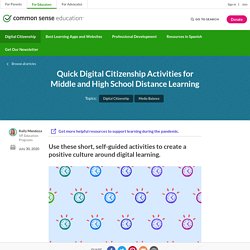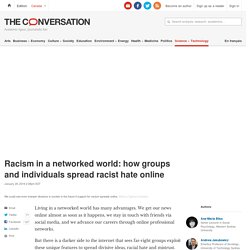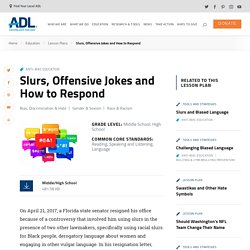

Quick Digital Citizenship Activities for Middle and High School Distance Learning. Use these short, self-guided activities to create a positive culture around digital learning.

Digital citizenship will be especially important this fall as middle and high school students across the country return to school virtually, in one form or another. Students will be on their devices, communicating, collaborating, and creating with digital tools more than ever before. But amid the pressures of distance learning, we know that educators may not have as much instructional time for things like digital citizenship. To address this, we've pulled together a collection of short digital citizenship activities that students can complete independently, or with parents or caregivers. All the videos and games below emphasize the importance of digital citizenship as a foundation for digital learning. Watch and Reflect Videos: 15-Minute Activities Our videos are a great way to spark critical thinking and discussion around a variety of digital citizenship topics. 6th Grade 7th Grade 8th Grade.
I 2 Legal Issues. Cyberbullying infographic. Lesson cyberbullying law grades7 8. Harassment. Build a Digital Citizenship Lesson Plan for Middle School Students. Racism in a networked world: how groups and individuals spread racist hate online. Living in a networked world has many advantages.

We get our news online almost as soon as it happens, we stay in touch with friends via social media, and we advance our careers through online professional networks. But there is a darker side to the internet that sees far-right groups exploit these unique features to spread divisive ideas, racial hate and mistrust. Scholars of racism refer to this type of racist communication online as “cyber-racism”. Even the creators of the internet are aware they may have unleashed a technology that is causing a lot of harm. Since 2017, the inventor of the World Wide Web, Tim Berners-Lee, has focused many of his comments about the dangers of manipulation of the internet around the spread of hate speech, saying that: Humanity connected by technology on the web is functioning in a dystopian way. Slurs, Offensive Jokes and How to Respond.
On April 21, 2017, a Florida state senator resigned his office because of a controversy that involved him using slurs in the presence of two other lawmakers, specifically using racial slurs for Black people, derogatory language about women and engaging in other vulgar language.

In his resignation letter, Senator Frank Artiles wrote: “My actions and my presence in government is now a distraction to my colleagues, the legislative process, and the citizens of our great State. I am responsible and I am accountable and effective immediately, I am resigning from the Florida State Senate.” This is just one example that got media attention; however, it seems that slurs, epithets and offensive jokes are part of our everyday lives and many people are unsure what to say or do when confronted with this offensive language. Memes: Fun waste of time or incredible literacy integration tool?
We all love a good meme.

Visual. Easy to understand. And just the right amount of snark. But can we use them as part of our instructional designs? Or are they just a questionable way to spend way too much time online? Now? I’m starting to believe the combination of visuals and text needed to create a good meme can be used in a variety of ways. So . . . today, a few meme / social studies / literacy integration ideas: Digital Citizenship Curriculum. Instagram photos and videos. From Etiquette to Power: A New Type of Digital Citizenship Education - Michelle Ciccone.
Ethan Lindenberger: Why we need to fight misinformation about vaccines. Trolls spread hateful fake Starbucks coupon for 'people of color only' Critical Media Project. Global Action Project. Edutopia. Media Literacy, Social Justice, and Teaching. By: Ankur Singh The turn of the 21st century was accompanied by a huge surge in media technologies, revolutionizing how people communicate with each other.

Millennials spend an average of about 18 hours a day exposed to various forms of media This heavy media saturation highlights the importance of why students need to know how to critically analyze the messages they are constantly bombarded with. Just as schools require students to know how to read and write literature, they should also be taught how to “read” and “write” media, especially considering how imagery and representation can have a huge impact on our beliefs and opinions.
This is particularly important during the developmental phase of adolescence when media exposure can influence a young person’s physical, moral, emotional, and cultural aspects of identity. Public perception is very much shaped by how events and narratives are framed in the media. Like this: Like Loading...